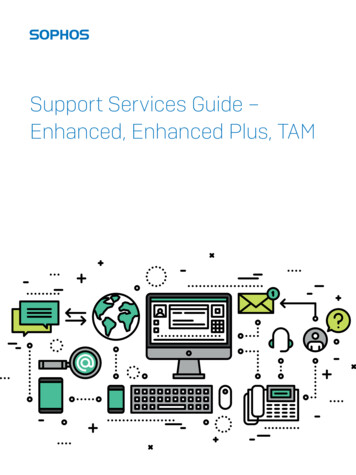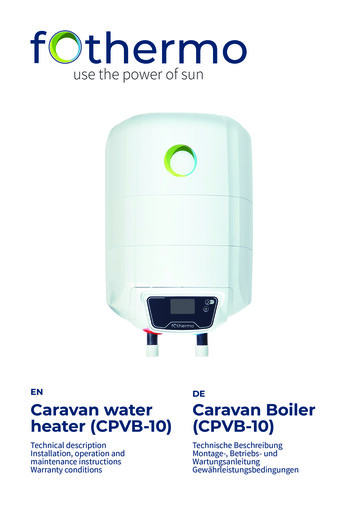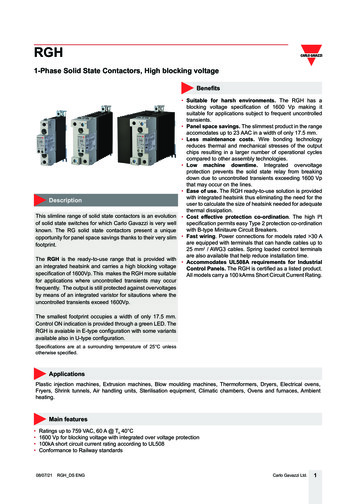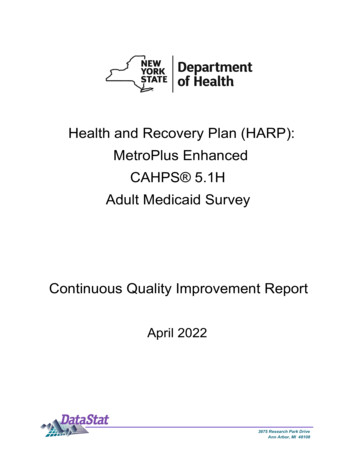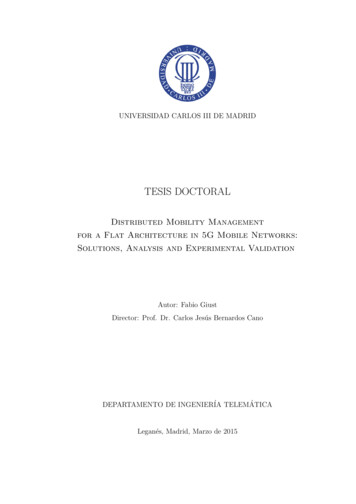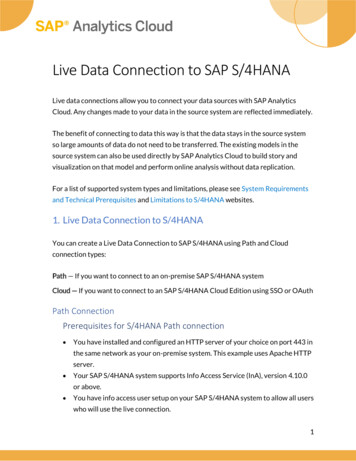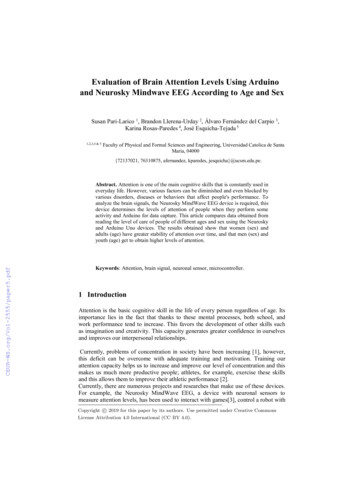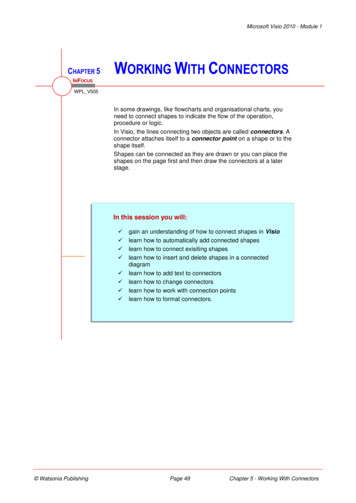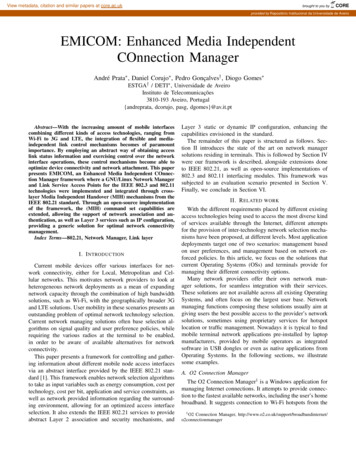
Transcription
View metadata, citation and similar papers at core.ac.ukbrought to you byCOREprovided by Repositório Institucional da Universidade de AveiroEMICOM: Enhanced Media IndependentCOnnection ManagerAndré Prata , Daniel Corujo , Pedro Gonçalves† , Diogo Gomes ESTGA† / DETI , Universidade de AveiroInstituto de Telecomunicações3810-193 Aveiro, Portugal{andreprata, dcorujo, pasg, dgomes}@av.it.ptAbstract—With the increasing amount of mobile interfacescombining different kinds of access technologies, ranging fromWi-Fi to 3G and LTE, the integration of flexible and mediaindependent link control mechanisms becomes of paramountimportance. By employing an abstract way of obtaining accesslink status information and exercising control over the networkinterface operations, these control mechanisms become able tooptimize device connectivity and network attachment. This paperpresents EMICOM, an Enhanced Media Independent COnnection Manager framework where a GNU/Linux Network Managerand Link Service Access Points for the IEEE 802.3 and 802.11technologies were implemented and integrated through crosslayer Media Independent Handover (MIH) mechanisms from theIEEE 802.21 standard. Through an open-source implementationof the framework, the (MIH) command set capabilities areextended, allowing the support of network association and authentication, as well as Layer 3 services such as IP configuration,providing a generic solution for optimal network connectivitymanagement.Index Terms—802.21, Network Manager, Link layerI. I NTRODUCTIONCurrent mobile devices offer various interfaces for network connectivity, either for Local, Metropolitan and Cellular networks. This motivates network providers to look atheterogeneous network deployments as a mean of expandingnetwork capacity through the combination of high bandwidthsolutions, such as Wi-Fi, with the geographically broader 3Gand LTE solutions. User mobility in these scenarios presents anoutstanding problem of optimal network technology selection.Current network managing solutions often base selection algorithms on signal quality and user preference policies, whilerequiring the various radios at the terminal to be enabled,in order to be aware of available alternatives for networkconnectivity.This paper presents a framework for controlling and gathering information about different mobile node access interfacesvia an abstract interface provided by the IEEE 802.21 standard [1]. This framework enables network selection algorithmsto take as input variables such as energy consumption, cost pertechnology, cost per bit, application and service constraints, aswell as network provided information regarding the surrounding environment, allowing for an optimized access interfaceselection. It also extends the IEEE 802.21 services to provideabstract Layer 2 association and security mechanisms, andLayer 3 static or dynamic IP configuration, enhancing thecapabilities envisioned in the standard.The remainder of this paper is structured as follows. Section II introduces the state of the art on network managersolutions residing in terminals. This is followed by Section IVwere our framework is described, alongside extensions doneto IEEE 802.21, as well as open-source implementations of802.3 and 802.11 interfacing modules. This framework wassubjected to an evaluation scenario presented in Section V.Finally, we conclude in Section VI.II. R ELATED WORKWith the different requirements placed by different existingaccess technologies being used to access the most diverse kindof services available through the Internet, different attemptsfor the provision of inter-technology network selection mechanisms have been proposed, at different levels. Most applicationdeployments target one of two scenarios: management basedon user preferences, and management based on network enforced policies. In this article, we focus on the solutions thatcurrent Operating Systems (OSs) and terminals provide formanaging their different connectivity options.Many network providers offer their own network manager solutions, for seamless integration with their services.These solutions are not available across all existing OperatingSystems, and often focus on the largest user base. Networkmanaging functions composing these solutions usually aim atgiving users the best possible access to the provider’s networksolutions, sometimes using proprietary services for hotspotlocation or traffic management. Nowadays it is typical to findmobile terminal network applications pre-installed by laptopmanufacturers, provided by mobile operators as integratedsoftware in USB dongles or even as native applications fromOperating Systems. In the following sections, we illustratesome examples.A. O2 Connection ManagerThe O2 Connection Manager1 is a Windows application formanaging Internet connections. It attempts to provide connection to the fastest available networks, including the user’s homebroadband. It suggests connection to Wi-Fi hotspots from the1 O2 Connection Manager, nnectionmanager
operator, and integrates with the operator’s cellular donglehardware supporting SMS services in the desktop application.B. AT&T Communication ManagerThe AT&T Communication Manager2 is a desktop application for taking advantage of the operator’s 4G network in theUnited States. It works in Windows and Mac OS, and alsomanages Wi-Fi connections, handling the authentication toAT&T Wi-Fi hotspots. The application provides real time datausage management, and allows the creation of mobile hotspotsfor sharing internet access with multiple Wi-Fi enabled mobiledevices. In addition, the application uses the operator’s cellularnetwork, or integrated GPS chips on proprietary devices, toprovide location services, namely for locating Wi-Fi hotspots.C. GNU/Linux NetworkManagerThe GNU/Linux NetworkManager3 (NM) application ispresent in most, if not all, desktop GNU/Linux distributions.It aims to provide constant network connectivity, featuringIPv4 and IPv6 support, WEP, WPA/WPA2 and 802.1X securitymechanisms, and the ability to control many network devicesincluding Ethernet, Wi-Fi, WiMAX and 3G modems.NetworkManager provides a D-Bus interface for DesktopEnvironment and GUI configuration interfaces. Users provideconfigurations for each network they want to include, andNetworkManager tries its best to keep the user connected, preferring secure connections first, then selecting Access Pointswith stronger signals. Moreover, it always attempts to acquirea connection with every available network interface, unless theuser explicitly requests disconnection of an interface.D. InterDigital Smart Access ManagerInterDigital’s Smart Access Manager4 (SAM) is a clientfor mobile devices that makes network selection and trafficmanagement decisions between Wi-Fi, 3G and LTE networks.This is a solution for network providers that aims to provideterminal functions for Wi-Fi offloading and maintaining userQuality of Experience (QoE) on the provider networks via theAccess Network Discovery and Selection Function (ANDSF).The client supports dynamic selection between hotspots, giving preference to user-configured Wi-Fi networks. It performsIP traffic routing between networks when both Wi-Fi andcellular access are available, thus enforcing provider policieson terminal devices.E. Solution ComparisonThe previous sections do not attempt at an extensiveoverview of the available solutions. Solutions from serviceproviders often fail to address multiple network technologies,since they focus mostly on their provided services, and usuallyWi-Fi for offloading [2]. Generic solutions, on the other2 ication-manager/index.jsp3 NetworkManager/4 InterDigitalSmart Access Manager, nd, do not provide much information or special featuresregarding interface and network selection. Of the mentionedsolutions, only SAM uses a mechanism for requesting helpfrom the network for attachment decisions. Table I provides acomparison of the various features for each solution.SAM is considered a Multi-OS solution since it supportsvarious smartphone devices, but it is not intended for desktopusage. Although also listed as non-Multi-Operator, it probablydepends on the configuration that each operator requires forthe deployment of the amic OptimizationsNetwork decisionsOpen nonoyesSAMyesyesnoyesyesnoTable IS OLUTION FEATURES COMPARISON .III. S UPPORTIVE T ECHNOLOGIESConsidering the previous shortcomings presented by thenetwork manager solutions illustrated in Section II, we introduce in this section a set of supporting mechanisms which,associated to those network managers, would complementthem with the lacking behaviour.A. IEEE 802.21The IEEE 802.21 [1] standard enables seamless handoverbetween heterogeneous technologies. This framework is basedon a protocol stack implemented in all the devices involved inthe handover. It exposes a common L2 interface for IEEE802 and 3GPP technologies in order to facilitate networkhandovers, thus a Media Independent Handover (MIH) framework. It considers several network components: Mobile Node (MN): This is the network attachmentcandidate itself. Point of Attachment (PoA): The network endpoint forL2 connection to the MN. Point of Service (PoS): A network entity that providesinformation to the MN and takes network configurationactions in order to optimize MN handovers. Non-PoS: An IEEE 802.21 entity that contains staticinformation regarding network policies and topologies.These entities are interconnected by an MIH Function (MIHF)through the MIH Network Service Access Point (SAP) interface. It also handles the communication exchanges between thelower layer entities, through the MIH Link SAP and higherlayer entities (MIH Users), through the MIH SAP. The MIHSAP provides MIH Users with a large set of technologyindependent primitives for interface control and informationgathering. The MIH Link SAP provides a mapping betweenthe 802.21 primitives and the technology-specific lower layerinterfaces. The MIH primitives are grouped in the Event,Command and Information Services.
1) Event Service: Events can be initiated either by the MNor by the network. They originate from lower layers or MIHF,at the MN, at the network PoA or the PoS, and are propagatedto interested MIH Users, local or remote. MIH Users declaretheir interest in certain events by subscribing them. MIH eventspertain to the following factors: Link State Change events: This includes events to notifyof link layer occurrences such as the loss or establishmentof L2 connectivity. Link Parameter events: These events are generated inresponse to configured thresholds pertaining to link-layerparameters such as packet loss, signal strength, etc. Predictive events: Such events convey the likelihood ofa change in the link conditions in the near future based onpast and present conditions, such as the decay in signalstrength in relation to a PoA. Link Transmission events: These events can be subscribed to receive indication of the link layer transmissionstatus of individual upper layer PDUs.Events are mostly advisory in nature, which means Userssubscribing to a set of events are not required to act on them.2) Command Service: MIH Users utilize command servicesto determine the status of links and/or control the devicefor optimal performance. Commands can be delivered locallyor remotely, and are classified in two main categories: MIHCommands and Link Commands.Link commands are delivered from the MIHF to the LinkSAPs, on behalf of the MIH Users, for various control operations, through the following primitives: Capability discovery and event subscription: A linkmay be queried in order to determine its supportedprimitives both for the command and event service. Linkevents must be subscribed for receiving notifications ona per-link basis. Parameter retrieval: Various active link parameters canbe obtained through Link commands, such as the current bit rate, Quality of Service (QoS) statistics, signalstrength, etc. Threshold configuration: Link parameter events can beconfigured for future reception over the event service.Thresholds may be configured for obtaining periodicreports or only indications that a parameter value hasbeen crossed. Link control: A single primitive offers various actions torequest a link to perform, including radio scans, changingits operational state or going into power save mode.MIH Commands are sent by the higher layers to the MIHF.They may originate locally, through the MIH SAP, or remotely,through the MIH Network SAP. MIH Commands may translateinto specific Link Commands operations, or aid in handoverdecision procedures by the following requests: Handover candidate query: Both the MN and theNetwork may issue this command in order to exchangesuggested networks and associated points of attachmentinformation for possible handovers.Query resources: This command is used to assess orprepare network resources in a target network for MNhandover. Handover commit: For MN controlled handovers, this isused to inform the serving network of the target decision.For Network controlled handovers, this command informsthe MN of which network to attach to. Handover completion: This command allows both serving and target networks to indicate the completion statusof a handover operation.3) Information Service: The Information service is a collection of mostly static information elements about networks andoperators. These elements provide information essential to thenetwork selection algorithm to make a successful handoveracross heterogeneous networks and technologies. A MobileNode benefits mostly from this service by being able to querygeographically surrounding networks, as well as their servicecapabilities before making a handover decision or even powering other radio interfaces. For example, information about anearby Wi-Fi hotspot could be obtained using a 3G interfacewithout the need to power the Wi-Fi radio. It may also be usedto query target network information regarding security or QoSmechanisms, thus influencing the target selection.4) Media Specific Mappings for SAPs: The MIHF aggregates disparate interfaces with respective media dependentlower layer instances into a single abstract interface for MIHUsers, reducing the inter-media differences to the extent possible. For the most part, existing primitives and functionalityprovided by different access technology standards are used.Amendments to existing standards are proposed when deemednecessary to fulfil the MIHF capabilities.The Link Service Access Point (LSAP), defined in theIEEE 802.2 [3] standard, provides the interface between theMIHF and the Logical Link Control (LLC) sublayer acrossboth IEEE 802.3 and 802.11 networks. However, the completeMIH LINK SAP set of primitives mappings for 802.11 requires an enhancement proposal defined in IEEE 802.11u [4],in the form of the MAC State Generic Convergence Function(MSGCF).The interface for 802.16 networks depends on the C SAPand M SAP, both defined in IEEE 802.16g [5].A special SAP, MIH 3GLINK SAP, is defined for interfacing with the MIHF and the different protocol elements of the3G system. B. Converging decision processesWith different kinds of access technologies available tomulti-interface mobile terminals, achieving an optimal handover decision depends on multiple parameters [6], rangingfrom:1) The dynamics of the wireless strata (e.g., signal-noiseratio, available bandwidth, cell load);2) Requirements placed by the service content being accessed (e.g., minimum latency);3) Requirements placed by the user (e.g., perceived videoand/or audio quality, cost);
4) Network conditions (e.g., cell load, requested service,policies).The different criteria involved must not only take into consideration the capabilities of the service being provided, butalso the resources available in the network and, ultimately, theuser satisfaction. As such, optimal handover decisions have theneed to assess different objectives, from different layers of thenetwork stack, in order to achieve an Always Best Connected[7] solution.In this sense, different schema are possible, varying betweenmobile terminal centric decisions [8], and network controlleddecisions [9], or even combinations of both where the perspective of the terminal and network come together to optimize thehandover decision to a broader set of requirements [10].However, a common requirement for optimized handoverprocesses relies on the flexibility and simplicity of networkmanager application design, contributing for the facilitateddeployment of such mechanisms in different kinds of mobileterminals using a broad spectrum of access technologies. Assuch, in this work, we consider the integration of MediaIndependent mechanisms within the fabric of network managerapplications, aiming at mainly two things: abstracting information and control capabilities from different kinds of accessinterfaces; and empowering such applications with the meansto disseminate that information and control with local decisionentities, as well as network-controlled remote entities whenavailable. This constitutes the setting for our Enhanced Media Independent COnnection Manager framework, EMICOM,presented next.IV. F RAMEWORKThe developed framework is based on an open source MIHFimplementation, ODTONE5 , supporting the whole range ofMIH services. It provides a set of Application ProgrammableInterfaces (APIs), enabling the development of custom MIHUsers and Links to interface with the provided MIHF. TheseAPIs are based on socket message transport, which enables thereuse of the solutions between multiple Operating Systems.The mechanisms presented by the IEEE 802.21 standardcan be considered as an abstraction for Media Independentinterface management. Not only this common interface provides easier interface control, it also exposes common information enabling network managers to employ a plethora ofnew network selection algorithms based on application andservice requirements, power constraints, and other requirements. However, the 802.21 services do not provide all thenecessary primitives for interface management. For example,the procedures for network association are outside of the scopeof the standard. Also, since it aims to provide an abstractiononly at the link layer, there is no support for network layerconfiguration.This section introduces our network manager framework bydetailing how such concepts can be integrated with 802.21,as well as identifying key enhancements done over the basestandard, enhancing its functionality.5 ODTONE,Open Dot Twenty ONE, http://atnog.av.it.pt/odtoneA. MIHF Cross-layerThe open-source nature of the ODTONE software collectionallowed an extension to the 802.21 protocol in order to keepthe advantages of interface agnostic control, and thus notrequiring specific hardware or OS support for operation. Theproposed extension refers to operations within the MobileNode only.Association and security procedures require link layer support from supplicant software. IP configuration requires assigning IP addresses to interfaces, as well as default gateways,custom routes, and DNS servers. As such, for these tasks, twoadditional Command Service primitives were integrated intothe 802.21 mechanics, for both the MIH SAP and MIH LinkSAP, providing the following functionality: Link configuration: Attach to a given network, providingthe necessary authentication, association and securityinformation. L3 configuration: Configure a set of networking properties on an interface, such as IP address, static routes andlist of DNS servers.Network authentication protocols such as 802.1X [11] providemany authentication mechanisms, some requiring an indefinitenumber of exchanges between the supplicant and the authentication server (i.e., depending on deployment scenarios), andpossibly demanding user input. This can be interpreted as anetwork request for the user, and can be implemented throughthe 802.21 Event Service. The following primitive was addedto the 802.21 mechanics: Link configuration required: Indicates a network request for authentication material from the supplicant.Using these commands, MIH Users are abstracted from specific protocols such as DHCP or stateless auto-configuration.An MIH User requesting Layer 3 configuration may requestattribution of specific IPv4 or IPv6 addresses, but it may aswell ask the framework to attempt DHCP configuration, forexample. The same is true for the Link configuration primitive;the required parameters for the specific network are providedimmediately in the Link configuration request. The frameworkthen implements the architecture of Figure 1.In this sense, our Network Manager assumes the role ofMIH User, interfacing with an enhanced MIHF implementedover the ODTONE open-source software, thus empowering itto not only access different kinds of link layer technologiesin a media-independent way, but also to abstract securityassociation and address requesting processes.B. Link Interfaces Service Access PointsSupporting this framework requires implementing LinkSAPs for various network device technologies. These components require direct communication with the OS softwareor interface drivers, whose implementation is platform dependent. For the specific case of GNU/Linux, two Link SAPimplementations were developed, and added as open-sourcesoftware to the ODTONE project, for the IEEE 802.3 and802.11 technologies.
Network Manager.MIHF (ODTONE)DHCP, DHCPv6, stateless autoconfig, .WEP, WPA, 802.1X, .UMTS802.3Figure 1.802.11.EMICOM framework architecture.The Linux kernel offers two main interfaces for networkdevice control, both over the Netlink [12] protocol: RouteNetlink and the nl80211 family over the Generic Netlinkprotocol. These interfaces provide some simple link controlfunctionalities exposed by the Linux kernel, which wereexploited in our work to produce the LINK SAPs. The RouteNetlink interface enables access to the networking subsystemof the Linux kernel by providing a set of primitives for adding,getting and removing information from its internal tableoriented data structures. For security mechanisms support, anddynamic IP configuration, external tools are also used.1) Route Netlink: This interface provides the full mappingfor 802.3, and a partial mapping for the 802.11 Link SAP,according to 802.21 primitives and parameters. It offers threegroups of messages of particular interest, for manipulation ofdifferent aspects common to all Linux network interfaces: LINK messages: Allow a user of the Route Netlinkprotocol to manipulate information about network interfaces on the system. These messages contain attributesfor indicating link state and device power changes. ADDR messages: Used for manipulation of IP addressesof the network interfaces. These messages support IPv4and IPv6 addresses, and an interface can be assignedmultiple IP addresses. ROUTE messages: These messages baptise the wholeprotocol name and, as it points out, they refer to IProuting table management.These messages are used to get or modify attributes of a link,but can also be subscribed in order to receive notificationswhen the kernel signals changes to these objects.2) nl80211: This protocol offers an interface for the Linuxmac80211 framework, for Wi-Fi specific operations. Amongothers, the following mechanisms are exposed: Power control: In addition to the various interface statesoffered by the Route Netlink protocol, the nl80211 interface allows controlling a Wi-Fi interface’s power savemode for sleeping between Access Point (AP) beacons,as defined in the 802.11 standard.Scanning: The interface supports triggering scans at anymoment as well as the configuration of scheduled scansat regular intervals. The scan result provides a listing ofthe detected APs containing basic BSS attributes, as wellas the full listing of the beacon Information Elements. Association and Authentication: Linux supports various802.11 authentication methods. For security mechanisms,there are facilities for userspace applications to transmitraw packets as well as subscribing received packets bymeans of matching the first few bytes of the desiredframes. QoS:The mac80211 framework supports the802.11e [13] extension, and will assign frames tospecific hardware queues based on the Type of Service(TOS) field of the packet IPv4 header. IPv6 does notsupport the TOS field and uses Traffic Class codesinstead. Unfortunately, current versions of the Linuxkernel do not provide statistics such as minimum,average and maximum packet delay for individualClasses of Service, which is one of the features of the802.21 framework.Similarly to the Route Netlink interface, nl80211 allows thesubscription of certain occurrences. This includes events forL2 connection and disconnection, but also the signalling ofnew scan results and the crossing of a given signal strengththreshold.For easier Netlink message parsing and program memorymanagement, both the Route Netlink and nl80211 access aremediated by a custom C wrapper on top of the libnl6 library.3) Security Mechanisms: Support for network authentication mechanisms such as WPA2 and 802.1X is achievedwith the wpa supplicant7 software. wpa supplicant providesa text-based socket interface as well as a D-Bus API. TheLink SAPs interface with wpa supplicant via the D-Bus API,which supports adding network configurations and keyingmaterial at runtime. Requesting authentication to a networkcan be performed immediately or later. If the authenticationmechanism requires further parameters, the daemon signals theoccurrence of network requests indicating the required fields.4) IP Configuration: Dynamic IP configuration is supported via the Internet Systems Consortium’s DHCP8 software bundle. It provides a DHCP client, dhclient, supportingDHCPv4 and DHCPv6, as well as IPv6 Stateless AddressAutoconfiguration. Unfortunately, this program does not offerany sort of API, and its integration is done via scriptedcalls to the command line daemon, providing the appropriateparameters as command line options each time. DNS serversare configured by direct manipulation of system configurationfiles. C. Network ManagerThe aim of the Network Manager development was toreplace the existing NetworkManager software which is inte6 libnllibraries, http://www.infradead.org/ tgr/libnl/Supplicant daemon, http://hostap.epitest.fi/wpa supplicant/8 DHCP Client, https://www.isc.org/software/dhcp7 WPA
grated with most desktop environments via network configuration GUIs and panel applets via a freedesktop.org9 endorsedD-Bus API. This API includes the following interfaces forDesktop applications: NetworkManager: A main central object that offers aninterface for overall management tasks. This object holdsthe network device structure, the overall machine stateand individual connection states. Device: This is an abstract interface to represent commonattributes of all network devices. An object implementing this interface is associated to a unique networkdevice in the system. Each technology extends this interface for providing technology-specific features. TheDevice.Wireless interface, for example, provides a D-BusAPI for requesting scans, list of known APs, etc. AccessPoint: An AccessPoint object exposes propertiesto identify networks and determine how to properlyprepare the association to the BSS, such as the SSID,Frequency, Maximum bitrate, etc. Settings: The Settings interface may be regarded asthe system-global repository for the various configurednetworks. It exposes methods to add and retrieve configuration objects, containing the necessary informationfor each network, including authentication material, IPconfigurations (whether dynamic or static), etc.The services exposed by the NetworkManager D-Bus interface, otherwise implemented directly for each specific hardware implementation, must be converted to the MIH Servicesprimitives. In essence, regardless of the Device type exposedby the D-Bus API, the underlying object for interfacingthrough the MIHF is the same for every type. This base objectuses a reduced set of primitives for media independent devicecontrol: Link actions: Used to initiate scanning, disconnecting alink, and setting the device power state between on, offand power save mode. Link configure thresholds: Used to configure thresholdparameters for future event notifications. Link get parameters: Retrieve certain parameters of thecurrently established link. Link configuration: Used to request association andsetup of security mechanisms to a network. L3 configuration: Used to request IP configuration on alink.Similarly, reaction to device events is supported via the set ofprimitives of the MIH Event service: Link up: L2 connection is established on a link. Link down: L2 connection is lost on a link. Link detected: A PoA of a new network was detectedfollowing a scan. Link parameters report: Events generated regardingconfigured thresholds. Link configuration required: Additional procedures arerequired for security mechanisms.9 freedesktop.org,http://www.freedesktop.org/The MIH User, and the D-Bus interface, should be extendedwith further intelligence and algorithms for network selectiondecisions, depending on the target environment.V. E VALUATIONThe first aspect that needs to be evaluated from this abstractaccess to the interfaces is the framework footprint in a system.Since it is a multi process solution that relies on Inter Process Communication (IPC) mechanisms, there is an obviousoverhead in communication. It is also relevant to compareother aspects such as the amount of code that composes theframewor
tion Manager framework where a GNU/Linux Network Manager and Link Service Access Points for the IEEE 802.3 and 802.11 technologies were implemented and integrated through cross-layer Media Independent Handover (MIH) mechanisms from the IEEE 802.21 standard. Through an open-source implementation of the framework, the (MIH) command set .
